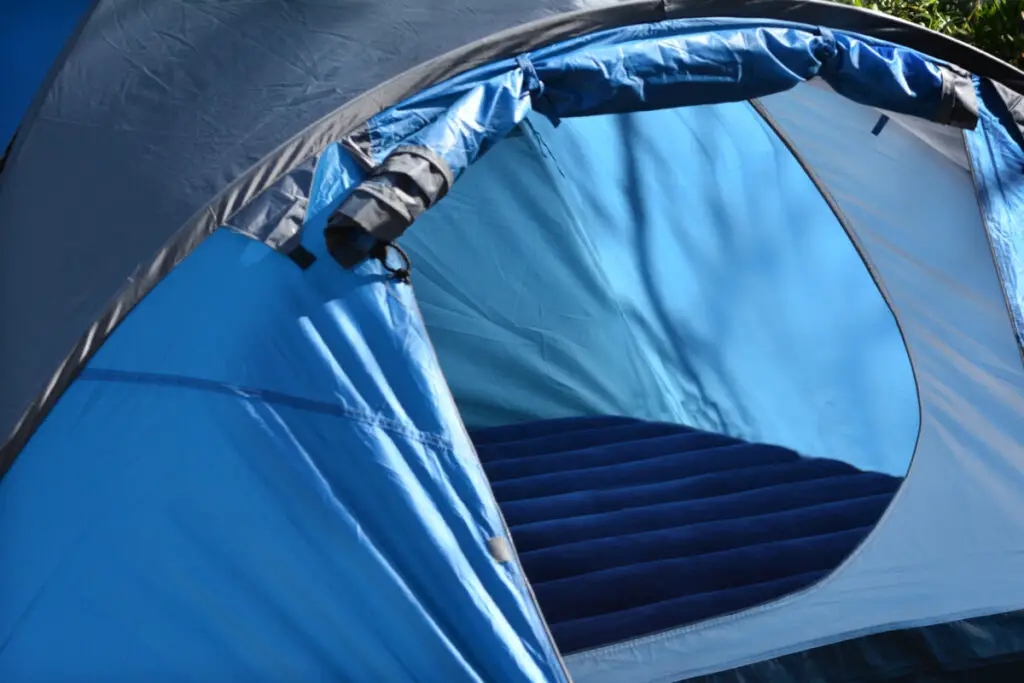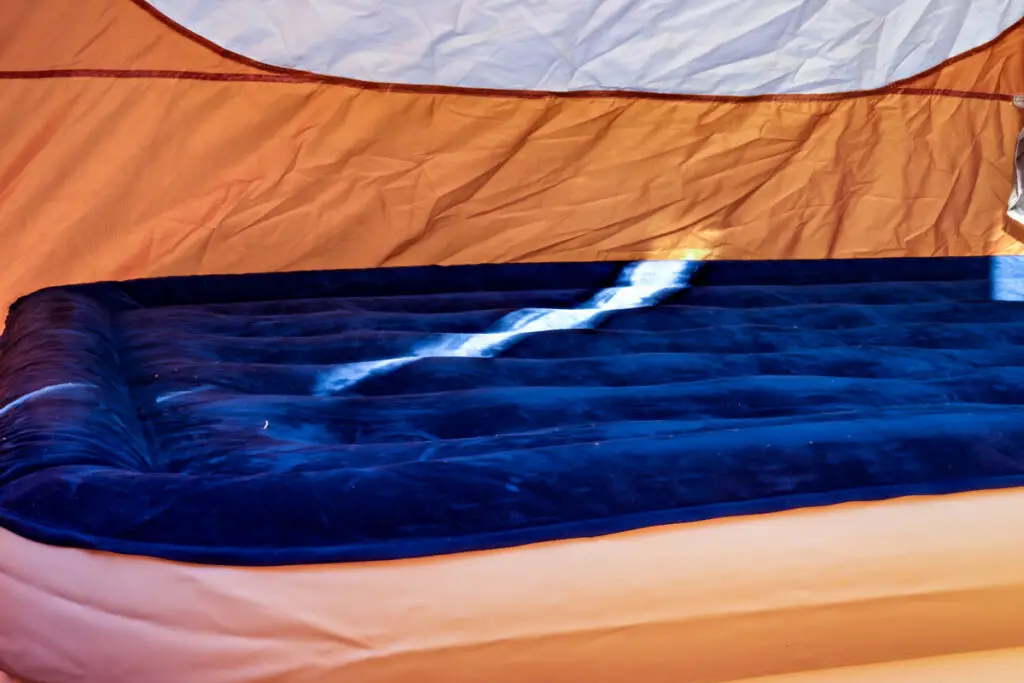
Camping with an air mattress is the only way some people can enjoy the great outdoors. Back problems, joint pain, and other health conditions all benefit from the extra padding. The problem is, air mattresses can also make the night unpleasantly cold.
To stay warm while sleeping on an air mattress outdoors, use insulation. First, wear extra clothing. Second, make extra layers on the top of the air mattress. Finally, make extra layers under and around the air mattress. If uninsulated, it will stay as cold as the air around it.
Anyone who’s tried to just use a sleeping bag on top of an air mattress can testify that it is not enough. For more information on staying warm during your next camping trip, keep reading below!
How to Stay Warm Camping on an Air Mattress
The first step to staying warm while sleeping on an air mattress is to understand why it gets so cold. Once you understand that, you can avoid getting chilled ever again.
Why Air Mattresses Are so Cold
Air mattresses are, as the name implies, full of air. Without intervention, this air is resting on the cold ground and is exposed on all sides to the cold night air. With nothing to warm it, the air in the mattress will be as cold as the surroundings. Every attempt by your body to warm it up will be wicked away by the pocket of air beneath you, leaving you freezing and miserable.
When you’re sleeping directly on the ground, your body will eventually warm the space beneath you. This happens faster if you have a little padding. With an air mattress, you will never warm the air faster than the air will cool you.
What You Can Do About It
The simple solution is to insulate your air mattress. If you can keep your body heat close to you, and if you can avoid the constant cooling of the air beneath you, you’ll be much warmer and more comfortable.
Insulating your air mattress is easy. After making sure that you’ve got yourself insulated with a good sleeping bag and warm clothing, you can insulate the top of the air mattress, then the sides, then the base. You’ll feel a difference immediately.
The Steps of Insulating Your Air Mattress

Insulating an air mattress is easy, and the effects are immediate when it’s done right.
First, Insulate Yourself
You don’t want to go through all the trouble of making a warm mattress just to sleep in shorts. If you don’t have a blanket, a sleeping bag, or some way to keep your body warm, you’ll want to address that before worrying about the air mattress.
Dress yourself according to the temperature. If it will be chilly, but not freezing, a basic sleeping bag or even some blankets should be adequate when combined with an insulated air mattress. If it will be freezing or below freezing, upgrade to an appropriate sleeping bag and warmer pajamas.
Always wear warm clothing, socks, and even a hat if you’re in a sleeping bag. Besides keeping you warmer, this also keeps your sleeping bag clean.
Second, Insulate Between Your Body and the Mattress
This is where you’re most likely to lose warmth while you’re sleeping. The air in the mattress can sap away your body heat when your sleeping bag compresses, especially if you’re using a down sleeping bag, and you’ll be chilled before you know it.
Cover your sleeping bag with a bedsheet, which will keep it warmer and cleaner, and then put a spare blanket between your body and the air mattress. You can do this above or below the sheet, depending on how much you move, and either option will be helpful.
Popular materials for insulating this area include:
- Wool Blankets
- Moving Blankets
- Old Comforters
- Flannel Sheets
- Foam Mattress Toppers
- Old Sleeping Bags
Whatever material you choose, make sure that it will keep you warm and that it won’t slip out from under you in the middle of the night. If you toss and turn, choose a wider option.
Third, Insulate around the Mattress
This keeps the air in the mattress from circulating back into the surrounding area as quickly. Simply putting a good flannel sheet around the mattress could be enough to make a difference. Since this is also helpful for insulating the top of the mattress, this is an easy fix.
Fourth, Insulate Between the Air Mattress and the Floor
If you’re camping on snow or frozen ground, this can be the trick that keeps you from feeling like you’re really camping on top of a refrigeration unit. Insulating the ground under the air mattress makes a big difference in keeping the warm air in and the cold air out.
You can insulate below the air mattress with tarps, moving blankets, newspapers, old blankets or quilts, or anything else you have on hand that won’t puncture the air mattress itself. If it gets dirty, that’s fine. It doesn’t have to be comfortable since you’re not sleeping directly on top of it.
If you’re sleeping in extremely cold conditions, this final layer of insulation can help keep you cozy and comfortable. A completely insulated air mattress will retain what heat it gets and will not disseminate more cold. When you’re camping, what more can you ask for?
Does the Type of Air Mattress Make a Difference?
This is a hotly debated question that depends on the amount of effort you’d like to put into insulating the air mattress. Yes, the type of air mattress can make a difference, but the difference isn’t as big as many people believe. The internet agrees that air mattresses are popular for a reason, even if some people say that sleeping pads are better.
Choose your air mattress based on your physical and transportation needs, then insulate it from there. If you’re using the mattress for backpacking, it’s probably best to stick with a camping pad that is filled with inflatable foam instead of air.
If you’re looking for a lightweight option with a little more built-in insulation, you can use a dedicated camping air mattress for your trip. If you’re only camping in cool weather, not cold, you might not need any additional insulation at all.
For car camping, or any other situation where you don’t need to physically carry in the air mattress, the type of air mattress does not make a difference beyond your personal comfort when sleeping on it. You’ll need to insulate anything you get if you’re camping in cool weather, so you may as well make it comfortable.
According to internet forums, even the cheapest air mattress can work well if you treat it right and prepare accordingly. People are just as happy with an $8 Walmart purchase as they are with a $200 REI purchase if they insulate it for the right temperature. If you’re using a car to reach your camping site, spend your money and energy on a good tent instead of worrying too much about the mattress.

The Best Air Mattresses for Sleeping Outdoors in Cold Weather
Even though people have very different opinions on what makes a good mattress and what makes them comfortable in cold weather, there are a few consistent features that people want in an air mattress for camping. They want it to be comfortable enough to sleep on, durable enough to use for more than one or two camping trips, simple to set up, and as easy as possible to keep insulated and warm without excessive effort.
With that in mind, here are some of the best air mattresses for camping in cold weather:
The Coleman Camping Cot and Air Mattress
This air mattress is nothing special by itself, with a simple pump and classic structure, but it made it onto this list anyway because it comes with a dedicated camping cot. The cot makes all the difference.
The Coleman Camping Cot and Air Mattress are made for practical camping. The cot can easily handle up to 600 lbs, it won’t break if you toss and turn in your sleep, and it’s easy to set up. Best of all, the cot keeps the mattress off of the cold ground and makes it much easier to insulate in the winter. Wrap it in a flannel sheet, top it with a warm foam mattress topper or a few extra blankets, and you’re good to go.
Even winter camping can be a cozy, comfy, pleasant experience once you’ve got this fully set up in your tent. If you have room in your car for a cot and a mattress, give this a try!
The REI Co-Op Kingdom Insulated Air Bed
This is a product that people either love or hate. The general consensus is that it is very nice for cool weather without added insulation, which is a huge plus for the purposes of this list.
People report that the REI Co-Op Kingdom Insulated Air Bed is warm, comfortable, easy to set up, and generally lasts for several days without needing to be re-inflated. This means that you can insulate it fully without worrying about uncovering it to access the pump every morning.
The downside is that manufacturing defects seem to be a little more common with this air mattress. Try it out in the comfort of your living room for a few days before committing to taking it camping with you. If you got a good one, fantastic! If not, return it and try again.
The Intex Twin 13″ DuraBeam Comfort Plush Mid-Rise Airbed Mattress
This air mattress is cheap, easily accessible at Walmart, and surprisingly popular with many campers. It can be used alone as a twin mattress, or paired with another twin mattress and covered with a foam or down mattress topper if a couple is camping on it.
Since the Intex DuraBeam Comfort Plus air mattress is not designed as an insulated mattress, and since it rests directly on the ground, it will need to be padded and insulated with blankets and mats when you go camping in the winter. Adding a mattress topper will help insulate the top and sides of the mattress, especially when combined with an extra flannel blanket.
Bestway 12 inch Queen Air Mattress with Built-in Pump
This Bestway 12-inch Queen Air Mattress with Built-in Pump is the ultimate cheap and easy camping air mattress option. With a price tag of under $30, you’ll have a lot of budget left for buying quality insulating materials to go with your new air bed.
There really aren’t many reported downsides to this bed. If anything, it is one of the most highly recommended of all the airbeds on the market. It’s cheap, it’s easy to set up, and it won’t break your heart if you puncture it on a stick while walking to your campsite.
One piece of advice given by other campers is that the material will stretch over the first few days or uses. With this in mind, don’t return the air bed if it seems like it’s deflating slightly. Give it a few more days of reinflating until the bed reaches the maximum stretch, then see if it’s holding its shape. If it doesn’t, you can return it, but you don’t want to panic-return a perfectly good air mattress that’s just adjusting to being inflated.
What Materials Can I Use to Insulate the Air Mattress?
Insulation makes all the difference when you’re camping with an air mattress. What you should use depends on your mattress, your needs, and the temperatures your camping trip will hit.
- Wool Blankets
- Wool blankets are always good to keep on hand when you camp. They can be used to insulate between your body and the mattress, pulled over on top of your sleeping bag for extra warmth, and cuddled around your shoulders early in the morning. Wool is durable, won’t need to be washed between every camping trips, and is very insulating.
- Extra Quilts, Blankets, or Comforters
- This is self-explanatory. If it’s a warm blanket, it can be used to insulate.
- Flannel Sheets
- Flannel sheets are great for wrapping all the way around the mattress. They’ll insulate the sides as well as the top.
- Non-Gel Mattress Toppers or Pads
- Mattress toppers are great, but be alert for anything that advertises cooling! That is the opposite of what you want.

